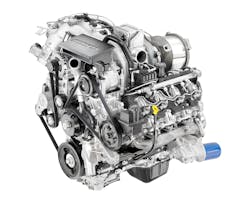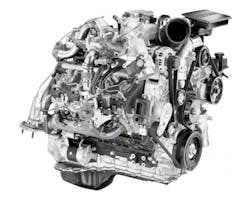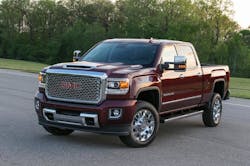The regulatory retooling of engines – even for pickup trucks
So we all know that the Phase 2 greenhouse gas (GHG) rules mandate fuel economy improvements for a wide variety of trucks, which in turn is leading to a whole host of changes to those vehicles – especially to their diesel engines.
The new 2017 designs offered by Cummins – the X15 series and X12 model – as well as those from Volvo and Mack, under-the-hood changes by Daimler Trucks North America (DTNA) to its 2018 Freightliner Cascadia (along with the introduction of the DD5 medium-duty engine in North America), plus tweaks made to the PACCAR MX lineup represent just some of the initial technological responses to the regulations promulgated by the Environmental Protection Agency (EPA) and the National Highway Traffic Safety Administration (NHTSA)
Every class of truck is being affected by the new rules – even pickups, though the Phase 2 rules are more lenient in their case.
According to EPA and NHTSA, heavy- and medium- duty pickup trucks and vans represent about 23% of the fuel consumption and GHG emissions within the heavy- and medium-duty vehicle sector.
Yet the Phase 2 standards for heavy-duty pickups and vans will apply largely in the same manner as the Phase 1 standards – thus, under this approach, all manufacturers face the same standards, but the average emission and fuel consumption rates applicable to each manufacturer depend on the manufacturer’s sales mix, with higher capacity vehicles (in terms of payload and towing) having less stringent targets.
Yet the light-duty OEMs aren’t sitting on their technological haunches where diesels are concerned.
Take General Motors as but one example, with its newly-redesigned Duramax 6.6-liter V-8 turbo-diesel, which will be offered on its 2017 model Chevrolet Silverado and GMC Sierra pickups.
GM said its retooled Duramax – which will be built at the OEM’s manufacturing facility in Moraine, OH, and will be available in the Sierra early in 2017 – will crank out 445 hp and a net 910 lb.-ft. worth of torque; some 19% more torque than what’s generated by the previous Duramax incarnation.
The redesigned Duramax also cuts noise at idle by 38% as well, due in large measure to a series of design tweaks a new, GM-developed control system, noted Gary Arvan, the engine line’s chief engineer, in a statement.
“Nearly everything about the Duramax is new, designed to produce more torque at lower rpm,” he said. “You’ll also notice the refinement improvements the moment you start the engine, and appreciate them as you cruise quietly down the highway — with or without a trailer.”
Dan Nicholson, vice president of global propulsion systems, added that the new Duramax 6.6-liter shares essentially only the bore and stroke dimensions of the current engine, with a lot of internal component changes:
- New, stronger cylinder block and cylinder heads
- New, stronger rotating and reciprocating assembly
- Increased oil- and coolant-flow capacity
- New exhaust gas recirculation (EGR) system with single cooler and integrated bypass
- New electrically actuated/electronically controlled turbocharging system
- All-new solenoid fuel system
- All-new electronic controls
- New full-length damped steel oil pan that contributes to quietness
- New rocker cover/fuel system acoustical treatments
- B20 bio-diesel compatibility
GM also developed a new patent-pending vehicle air intake system — distinguished on its heavy-duty pickups by what the OEM calls a “bold hood scoop” — to drive cool, dry air into the engine for sustained performance and cooler engine temperatures during difficult conditions such as pulling trailers on steep grades.
“Cooler air helps the engine run better under load, especially in conditions where engine and transmission temperatures can rise quickly,” Arvan noted. “That allows the Duramax to maintain more power and vehicle speed when trailering in the toughest conditions.”
Some things aren’t changing too much, though, GM stressed. As with previous versions, the new 6.6-liter Duramax block features a strong cast-iron foundation, with induction-hardened cylinder walls and five nodular iron main bearings.
Yet the new Duramax retains the same 4.05-inch and 3.89-inch bore and stroke dimensions as the current engine, retaining the Duramax’s familiar 403 cu.-in. displacement, GM added.
Here’s a deeper dive into some of the engine’s other major changes:
Here’s a neat little engineering twist to the new Duramax: the use of a “re-melted” combustion bowl rim for greater strength.
“Re-melting” is an additional manufacturing process for aluminum pistons in which the bowl rim area is reheated after casting and pre-machining, GM said, which creates a much finer and more consistent metal grain structure that greatly enhances thermal fatigue properties.
And, as noted before, the new Duramax can operate on B20 biodiesel, a fuel composed of 20% biodiesel and 80% conventional diesel – and it’s approved to do so right out of the gate.
That’s just a brief look at how diesel engines are changing not only to meet new regulatory requirements but deliver more benefits for truck owners across the commercial vehicle class spectrum.
And I’ve got no doubt this is only the start, as yet more improvements will be necessary as we continue down development pathways being created in part by GHG regulations.



